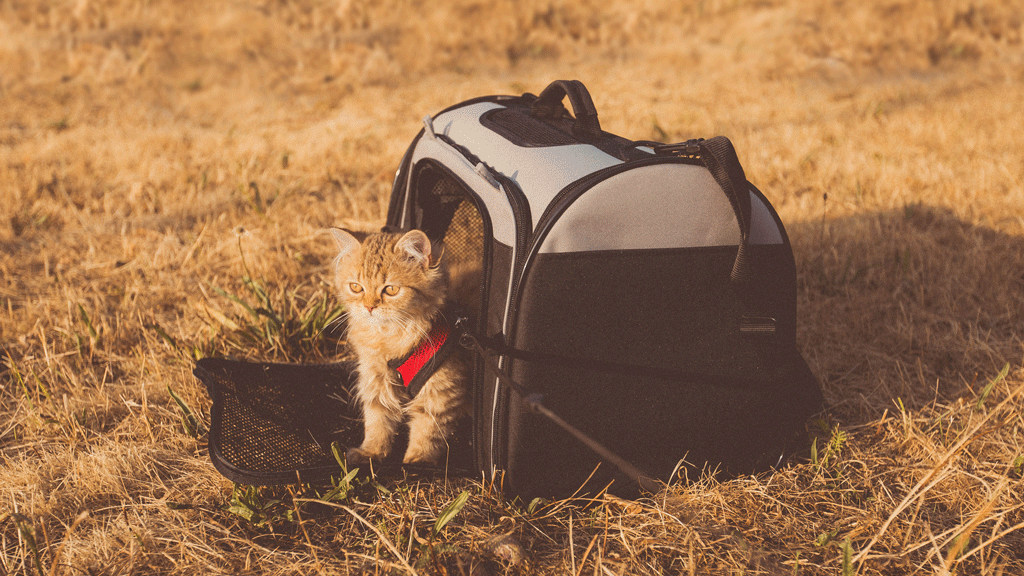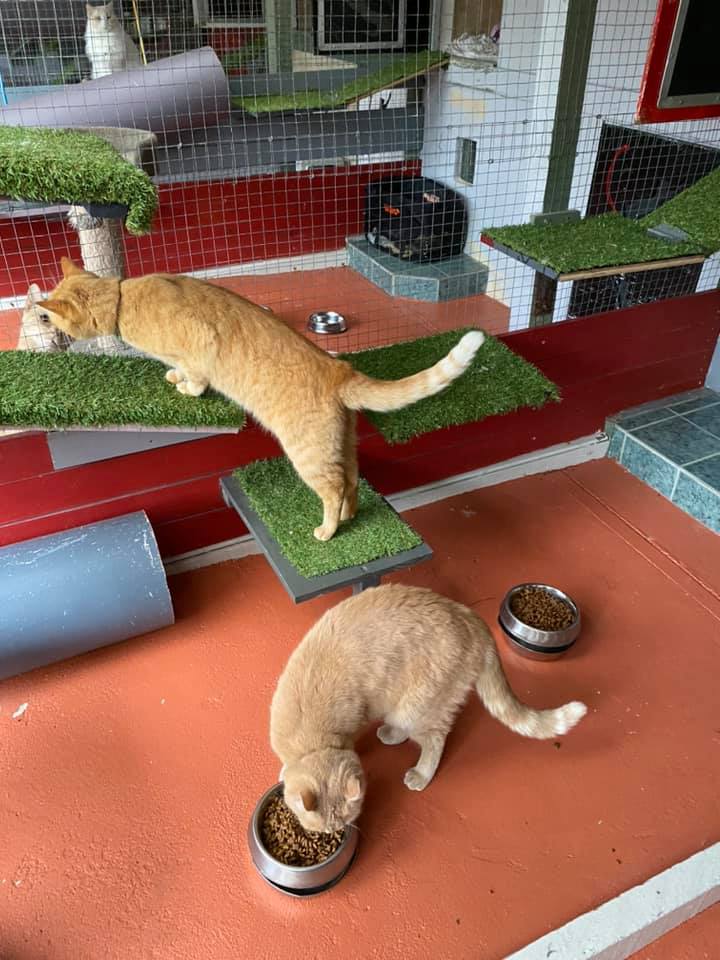15 Ways to Keep your Cat Calm in the Car
If you ask any cat owner one thing they always dread, it’s taking their cat for a ride in the car. But does it have to be such a chore? With the right methods, you can make the ride as smooth as possible.
If you’re ready to transition to smooth car rides with your feline, then you need to know all the tricks. Keep in mind that different cats will prefer other things, though. Take your cat’s personality into consideration when finding a method that’s right for them. Sometimes, it may take a little bit of trial and error before you see what’s “best.”
Choose a Carrier That is Right For Your Cat
The first and most crucial piece of the puzzle is finding the right Gold Coast cat kennel. There are two options to choose from: soft or hard. A soft kennel, as you might imagine, is made with soft materials. These are best for a relatively calm cat in the car and won’t be impulsed to scratch or bite the material to get out.
More ornery felines will need a rigid cat carrier. These hard kennels are ideal for cats that will plan to escape while in the car. These are typically smaller than soft kennels, making them far more compact to store while at home.
Make the Crate a Happy Place
Cats are finicky fellows, and their anxiety stops them from doing many things – and that includes venturing into new places. If you think you can plop a crate onto the floor and your cat will follow suit willy-nilly, then think again.
A new kennel in the house doesn’t have a scent, and there is nothing “comfortable” about it. A cat will see it and run for the hills. That’s why it is vital to make the crate a happy place and, more importantly, a safe place for your feline.
The best thing to do is to add some of your cat’s favorite things inside the kennel. This provokes them to enter the kennel. Once inside, the cat is greeted by a variety of soothing things. Some ideas include:
- A favorite blanket or towel.
- A few of their favorite toys.
- For hard carriers, a ping pong ball is an excellent choice to turn the kennel into a playground.
- Some of their favorite treats.
- A few sprays of FELIWAY Spray, which is a spray that releases pheromones. This is a calming scent for felines.
Get Your Cat Used to the Crate
Again, you can’t expect your cat to be happy with the crate right out of the gate. Cats will want to experience the box long before the car ride. So, if you know there is a trip (whether vacation or to the vet), then try and get your cat used to the crate beforehand. This isn’t always applicable, such as the case for sudden trips.
The best way to do this is to leave the crate inside the home. You can add some of their favorite items, such as those mentioned above. This will coax them into checking out the box on their terms. After a time, they should willingly enter the crate. At that point, it will be far easier to get your kitty out the door.
It is also recommended to start early. Although crate training isn’t done as often as it is done with hounds, it’s still a good idea. After adopting your kitty, get them used to the crate right away. Place them inside several times per week, along with some cherished items. They will grow up loving their kennel rather than hating it.
Place Your Cat in the Car Strategically
So, you have a cat that is now compliant about entering their kennel. That’s great and all, but you need to take your cat on the road. Unless, of course, you have the option of putting them in a Gold Coast cattery. But if you could leave them in Gold Coast catteries, then you probably wouldn’t be reading this article in the first place!
Your next obstacle is placing your cat in the car. The best thing to do is to be strategic about the placement. Some cats prefer to look outside, while others will need minimal visuals to reduce their anxiety. Again, this is where it all comes down to your cat’s unique personality. Placement is a learning curve.
Another thing to consider is that most cats feel secure when they can see their owner. So, if you can offer your cat a great seat where they have an excellent visual – whether it’s of the outside or nothing but the car – try and manage a spot where they can see you, too.

Allow Your Cat to Feel You
Some cats thoroughly enjoy being petted. Others find it to be the most annoying and horrendous thing possible. If your cat enjoys being pet regularly, make sure they are placed in a spot where you can give them your finger. They will enjoy rubbing their head and body against your finger, instantly providing comfort.
If your cat doesn’t like touch, then it’s relatively simple: keep your hands away from your furry friend. Otherwise, you will be doing far more harm than good.
Talk to Your Cat
Talking to your cat is another “hit or miss” tip that won’t work for every cat. But some cat owners swear by this trick and say it works like magic. Again, this is very cat-specific. If your cat enjoys spending time with you at home and prefers to hear your voice, then make sure you are talking to them throughout the trip.
Play Calming Classical Music
There is something so utterly soothing about classical music. It works on humans just as quickly as it does on felines. So, try it out. If none of these other methods prove to allow complete stress-relief for your kitty, it might be time to turn on the tunes.
Simply pull up classical music on YouTube. There are thousands of videos that play classical music on loop for several hours. If you notice your cat is reaching serenity with the music playing, then keep it on through the entirety of the trip.
Let the Cat Become Acquainted With the Car
If there is one thing that should be clear by now, it’s this: cats do not like new places. For most cats, their anxiety rises through the roof, and their caution is at a pique. This would cause anyone a fair amount of stress!
With that said, one easy way to make your cat more at ease in the car is to let them become acquainted with the vehicle before the trip. Of course, this should be done while the car is not in motion. It is never advised to drive when your cat is not in a crate. Driving with your cat standing freely can cause serious injury to your feline.
Instead, park the car and let your kitty inside. Ensure all of the windows and doors are locked, especially if you’re dealing with an escape artist cat. Keep the temperature in mind. During this acquisition, you may need to turn the air conditioning or heat on.
Start With Short Car Rides
When it comes to getting a cat to stay calm in the car, it comes down to careful planning beforehand. No cat is going to be okay with hopping into a crate and being on their way. It is just not that easy.
If you have time to prepare, start with the tip above that mentions getting them used to the crate beforehand. Let them get used to the car, too. Once they are accustomed to the kennel and the vehicle, you can move on to short car rides a few times per week. You can gradually increase the amount of time afterward.
Tire Your Cat Out Before the Trip
Tiring out might seem like a better tip for someone with a toddler, but it works with a kitty, too. A tired out feline will be less likely to put up a fight when it comes time to get in the kennel. Therefore, make sure he gets plenty of fun and exercise before the ride. Here are some top kitty favorites:
- Play with toys. Most of the time, cats like to play independently. They aren’t like dogs, who will strike up a game of fetch in no time. But you’re not out of luck. There are many ways for a cat to play, whether you buy a toy like this or opt for a pink pong ball.
- Play with a laser on the wall. There are many games that your cat can resist. However, one game that they can’t say no to is laser! All you need is some type of laser or flashlight. Spot it on the wall and let the cat chase it. Chasing a laser burns off energy quickly.
- Let your cat play in the cat tree. Cat trees are a cat favorite. Plus, it tires them out. If you haven’t busted out their new plaything yet, right before a car ride is the perfect time to do it.
- Bring some cat friends over. Some cats love to play with other cats. If your cat is one of them, then have a cat play date. They can run around and do “cat things” while you sit back and relax. By the end, they will be tired and ready to snuggle in their crate.

Keep Meals to a Minimum Day of the Trip
Cats aren’t so different from humans, after all. Some people who go on a car ride after eating a lot of food may end up feeling sick. Some cats are no different. To make sure it is a smooth trip that doesn’t end up with vomit every which way, keep meals to a minimum. No food is especially recommended in the few hours before the car ride.
Make Sure Your Cat Isn’t Suffering From Motion Sickness
Believe it or not, cats can get car sick, too. However, it isn’t the “turning green” experience that humans get. Cats have different signs and symptoms of motion sickness, including:
- Louder meowing than usual
- Pacing
- Restlessness
- Licking the lips excessively
- Drooling
- Lethargy
- Vomiting
- Diarrhea
If your cat experiences one of the symptoms mentioned above while riding in the car, they may be suffering from motion sickness. Motion sickness can be caused by several different things, including anxiety and being uncomfortable in the car. That’s why it’s essential to make sure they have a great crate and are acclimated to the vehicle.
To stop motion sickness from occurring, you can use calming herbs such as ginger and valerian. You can also take a trip to your cat’s veterinarian. They will be able to prescribe anti-nausea medication to stop the motion sickness. If the illness is due to stress, then an anti-anxiety medication may be used (sometimes in conjunction with anti-nausea medicine).
Don’t Forget to Check the Temperature of the Car
A comfortable ride can make all the difference from a content cat in the car to an unruly one. With that said, make sure the temperature is alright in your vehicle. If you’re too hot or cold, your cat is likely, also.
Don’t Make Unnecessary Stops
Even if your cat is a “good little kitty” on car rides, you shouldn’t press your luck. Although some cats don’t mind the occasional car ride, most aren’t happy with excessive time spent in a vehicle. Try to keep stops to a minimum.
As a Last Resort, Use Medication
Some cats suffer from extreme anxiety. This anxiety is raised to a higher threshold when asked to get into an unfamiliar spot, such as the car. If you have tried other methods and your cat is still unwilling to enter the vehicle peacefully, you might have to consider asking a vet for medication.
There are a few keys signs that show that your cat is feeling stressed, including:
- Excessive licking. While some licking is considered normal for grooming purposes, excessive licking is not. Not only will they lick themselves to oblivion, but they may even start to scratch and bite their bodies.
- Excessive meowing. When a cat is meowing more than usual, the cat is trying to tell you something. Sometimes, this “something” is that your cat is suffering from stress. If the meowing increases heavily in the car, it may be time to look into medication.
- Aggressive behavior. A lot of cats will resort to aggressive behaviors when they are overly stressed. If you typically have a happy-go-lucky kitty that turns into a nightmare in the car by hissing and attacking, then the vehicle may be to blame.
If your cat is suffering from anxiety, do not use Benadryl to calm him down. Many pet owners use this as a sedative, but it’s potentially dangerous for cat use. Instead, speak with your veterinarian about a cat-safe remedy.
Consider a Cattery For Longer Trips
Unless it is a vital trip to the veterinarian’s office, sometimes it’s best to leave the cat at home. Some cats simply won’t be happy, no matter what you do. Unfortunately, that means you will have a much harder time getting them to and from their appointments.
If you have a cranky cat that won’t love the car no matter what tricks you pull out of your hat, then consider leaving them in a Gold Coast cattery during your adventures. Gold Coast catteries are designed to keep your pet happy, safe, and healthy while you are away. Plus, they will get some time with other cats, which may be very beneficial and fun for some kitties.
Be Prepared for the Ride
Making sure that your cat is content during the car ride shouldn’t stop at the kennel. There are a few other things that may be beneficial along the way. Bring these items along for the ride, especially if you’re going a long distance:
- Food for your cat.
- Their favorite treats.
- Fresh water.
- Bowls for food and water.
- Clean cat litter and a litter pan.
- A brush or other favorite grooming tools.
- Medications necessary to keep your kitty content.
- A first-aid kit unless there is a kit-ty emergency.
- A collar and tag, unless it is on your cat already.
- A harness or leash.
- A few extra blankets and towels in case the materials become dirty.
- A bag to collect poop.
With these items, you will give your cat some food and water should they need it. There is also the option of calming them down with blankets and treats. You don’t have to worry about a mess in the kennel, either, by having kitty litter and a pan on hand.
Final Thoughts
Some cats don’t mind a ride in the car, but most can’t stand it. Luckily, there is a way around this. If you have the time and patience to work with your cat and make sure he is happy with his kennel, then you will no longer have an issue with car rides. If you try these tips and still have problems, speak with a professional about potential medications to help calm your kitty.
